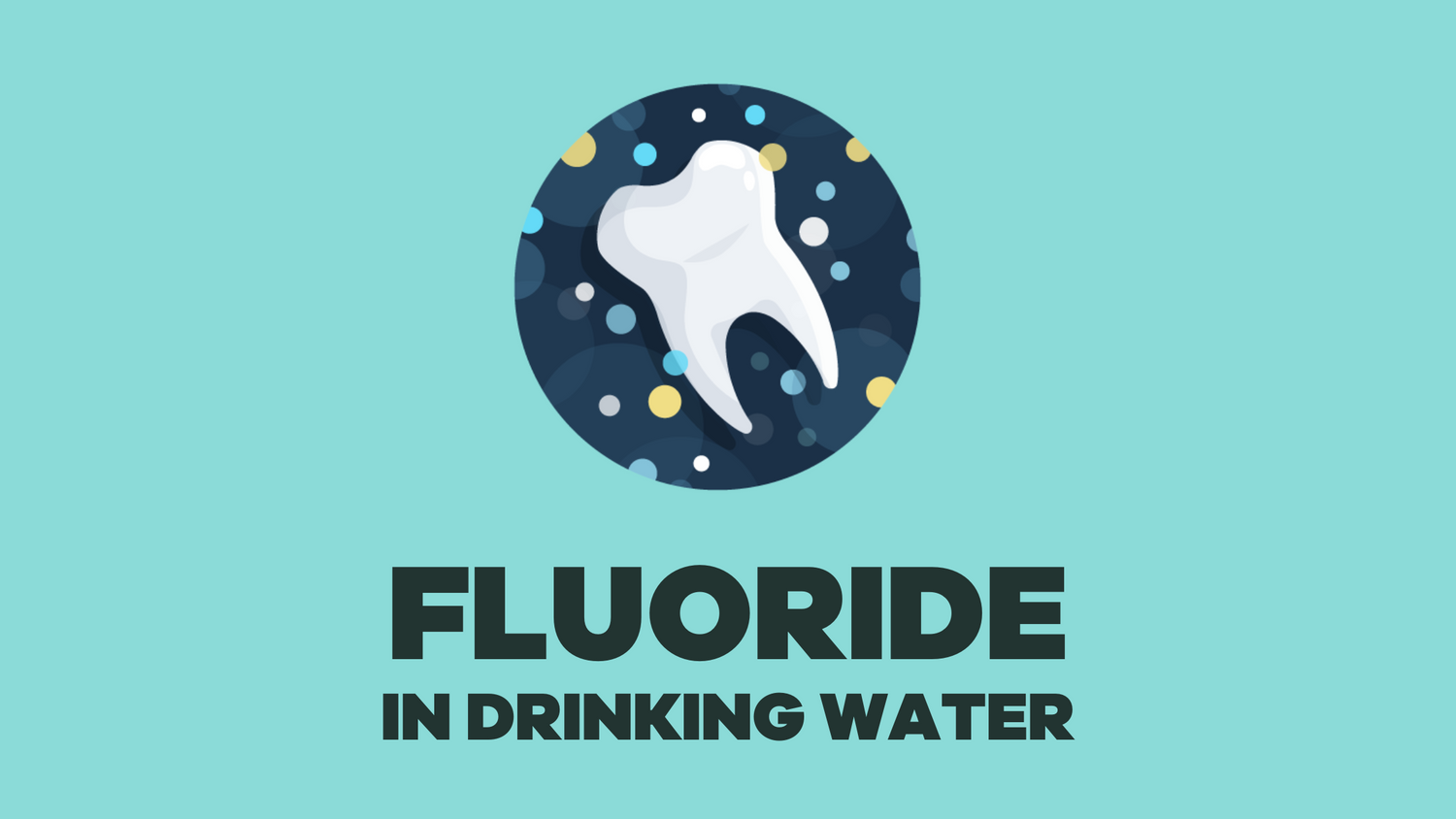
Why Is Fluoride Used in Water Treatment?
Our blog is written by real experts— not AI. Each guide is carefully reviewed and updated based on the latest research. Plus, with no affiliate links, you can count on unbiased insights you can trust.
What is fluoride and why is it used in water treatment? Fluoride occurs naturally and has been added to water supplies to help improve dental health. But with concerns and questions popping up more than ever, we're taking a closer look. We’ll tell you what you need to know in this quick guide to fluoride in drinking water.
Table of Contents:
- What Is Fluoride?
- Is Fluoride in Drinking Water?
- How Does Fluoride Affect My Health?
- What Are the Acceptable Levels of Fluoride in Drinking Water?
- How to Test for Fluoride
- How to Remove Fluoride
- What’s the Takeaway?
What Is Fluoride?
Fluoride is a naturally occurring mineral found in water and soil. Around 80 years ago, scientists noticed that American communities with higher natural fluoride levels in their water had fewer cavities. This discovery led to the widespread addition of fluoride to toothpaste and public drinking water to improve dental health. Fluoride also occurs naturally in groundwater in many areas, meaning that well water may contain fluoride even if it wasn’t added.
Is Fluoride Related to Fluorine, Chlorine, or PFAS?
No, although fluoride is often confused with other substances that sound similar, it is quite different from fluorine, chlorine, and PFAS. Here’s a breakdown of some common points of confusion:
-
Fluorine vs. Fluoride
- Fluorine: A highly reactive, dangerous gas
- Fluoride: A stable ion, commonly added to drinking water and dental products to protect teeth
-
Chlorine, Chloride, and Fluoride
- Chlorine: Like fluorine, chlorine is a reactive gas. Chlorine is used to disinfect drinking water, making it safe from harmful bacteria. In its pure form, chlorine can be dangerous, but when carefully controlled in water treatment, it serves a critical safety role
- Chloride: Chloride is a stable, naturally occurring ion, like fluoride. Despite their similar names, chloride is completely different from chlorine. Chloride is typically included in water tests but isn’t a health concern at normal levels
-
PFAS (Per- and Polyfluoroalkyl Substances)
- PFAS are man-made chemicals used in products like non-stick cookware and water-resistant clothing. They contain fluorine atoms, which is why "fluoro" appears in the name. However, PFAS are very different from fluoride and fluorine. Unlike fluoride, which can be beneficial at controlled levels, PFAS are persistent pollutants that can pose health risks even at low levels of exposure.
- PFAS are man-made chemicals used in products like non-stick cookware and water-resistant clothing. They contain fluorine atoms, which is why "fluoro" appears in the name. However, PFAS are very different from fluoride and fluorine. Unlike fluoride, which can be beneficial at controlled levels, PFAS are persistent pollutants that can pose health risks even at low levels of exposure.
Why Is Fluoride in Drinking Water?
Fluoride is intentionally added into public water systems at a level deemed safe by public health officials for the purpose of protecting against dental cavities. This makes fluoride common in drinking water, particularly in municipal tap water that comes from a public water system.
Is Fluoride in Well Water?
Any fluoride present in private wells is either naturally occurring (from the natural erosion of soil and rock deposits) or through contamination (from human activities such as aluminum intensive industries, pesticide or herbicide use and fertilizer production). Fluoride is not intentionally added to private wells like it is to public utility water.
A survey of fluoride in private wells by USGS shows that fluoride concentrations are typically low, < 0.7 PPM, while concentrations > 2.0 PPM are much less common.[1]
How Does Fluoride Affect My Health?
The relationship between fluoride and your health operates under a "Goldilocks principle"—both too much and too little can have negative effects, you need just the right amount:
Too Much Fluoride in Water Can Cause:
- Dental fluorosis: Dental fluorosis can occur when children are exposed to higher than recommended fluoride concentrations as their teeth are forming. Symptoms can be mild and include a light mottling of the teeth, and range to severe wherein teeth are misshapen and prone to breaking. The degree of fluorosis increases as the level of fluoride in the water increases; mild dental fluorosis can occur for some at fluoride concentrations in drinking water of around 1 PPM
-
Neurological impacts: Exposure to a fluoride concentration of 1.5 PPM in drinking water has been linked to lower IQ in children. While this consequence of fluoride exposure has been theorized and investigated for quite a while, it was recently reported conclusively by the National Toxicology Program (a program within the US Department of Health and Human Services)
- Skeletal fluorosis: Exposure to levels of fluoride over 3 PPM in drinking water over long periods of time can result in skeletal fluorosis, which causes denser bones, joint issues and limited range of motion. Crippling fluorosis, when the spine becomes completely rigid, can occur with long term exposure to fluoride at levels over 10 PPM
Too Little Fluoride in Water Can Cause:
- Risk of tooth decay: Insufficient fluoride leaves teeth more vulnerable to decay. Fluoride is essential for protecting tooth enamel, preventing cavities, and speeding up the repair of early-stage enamel damage. Public health officials recommend adding fluoride at levels around 0.7 PPM to drinking water

How Does the Right Amount of Fluoride Affect Dental Health?
Getting the right amount of fluoride is key. Fluoride helps protect your teeth. That’s why water utilities regulate fluoride levels to hit that "just right" balance for health. At low levels in drinking water, fluoride works to:
- Strengthen tooth enamel by slowing down demineralization and speeding up the remineralization process
- Prevent cavities by keeping a consistent, low level of fluoride in saliva and plaque, protecting teeth from decay
What Are the Acceptable Levels of Fluoride in Drinking Water?
In public water systems, fluoride is intentionally added at around 0.7 PPM, a level deemed acceptable by public health officials for the purpose of protecting against dental cavities. Fluoride is regulated at the federal level by the EPA.
- The EPA has set a federally-enforced Maximum Contaminant Level (MCL) for fluoride in drinking water at 4 PPM to protect against skeletal fluorosis
- The EPA has also set a non-enforceable Secondary Maximum Contaminant Level (SMCL) for aesthetic and cosmetic purposes at 2.0 PPM. This helps protect against dental fluorosis in children (considered a non-health-related outcome)
- If fluoride levels are above 2.0 PPM but below the 4.0 PPM MCLG, public water systems are required to notify consumers, particularly those with children, to take precautions
- States may set their own regulatory limits for fluoride, but theymust be at the level of the federal MCL or lower. California, for example, has a state MCL for fluoride of 2 PPM
Note: A federal court recently ruled that the EPA must further regulate fluoride or show that there is a sufficient margin between the hazard level and current exposure levels, due in part to the recent report showing neurological impacts at concentrations of 1.5 PPM in drinking water.[2]

Should I Be Concerned About Fluoride in Drinking Water?
Though fluoride can be present in both public and private water sources, it’s commonly below 0.7 PPM in private wells and at around 0.7 PPM in public water systems. Current recommendations maintain that this level of fluoride is safe in drinking water, though more research is needed in light of recent findings.
What is My Utility Doing to Monitor and Report Fluoride?
In addition to following federal and state (where applicable) regulations to monitor and regulate fluoride levels, your local utility reports its fluoride levels to its customers in an annual Consumer Confidence Report (CCR).
You can confirm this by looking up your CCR online or calling your utility.
How to Test for Fluoride in Water
Unfortunately, there is no easy way to test fluoride at home. Collecting a water sample and having it tested by a certified laboratory is the only way to reliably measure fluoride in tap water.
Do-it-yourself test strips or at-home test kits are not accurate enough for instances where tenths of a part per million play a role.
Tap Score has a number of certified lab testing kits available for fluoride:
- The most direct and cost-effective way to determine the amount of fluoride present in your water
- In addition to fluoride, this test provides a full panel of key water quality parameters that might be found in public utility water—including metals, minerals, inorganics, volatile organic compounds, petroleum compounds, and disinfection byproducts
- In addition to fluoride, this test provides additional water quality parameters relevant to well water, including indicator bacteria, metals, chlorine, chloride, and minerals
How to Remove Fluoride from Drinking Water
Fluoride can be removed from drinking water, but it requires specific methods. Unfortunately, standard carbon filters (e.g. pitcher filters and common faucet filters) are not typically effective at removing fluoride from drinking water. Effective methods to remove fluoride include:
- Membrane separation: Reverse osmosis, nanofiltration
- Activated alumina
- Anion exchange
Quick Guide to Certified Water Filters for Fluoride

How pH Can Affect Fluoride Water Treatment
Fluoride reduction is most effective within a near-neutral pH range (i.e. 6-8), which is where water utilities keep their drinking water supplies. But those reliant on private wells should keep an eye on pH levels. Acidic water can reduce the effectiveness of some treatment devices.

A water test like the kits listed above will reveal both fluoride and pH levels.
What’s the Takeaway?
- Fluoride is a naturally occurring mineral found in water and soil. It is intentionally added into public water systems at around 0.7 PPM—a level deemed safe by public health officials—for the purpose of protecting against dental cavities.
- Too much fluoride can lead to dental and skeletal varieties of fluorosis, and even neurological impacts. Too little fluoride can leave teeth vulnerable to decay.
- The EPA has set a federally-enforced MCL of 4 PPM for fluoride in drinking water. It has also set a non-enforceable SMCL for aesthetic and cosmetic purposes at 2.0 PPM.
- The only reliable way to determine fluoride levels at your tap is to have your water tested by a certified laboratory.
Read More
▾What You Need to Know About Chlorine and Chloramine
PFAS in Drinking Water: Everything You Need To Know
Why People Test Their Water






